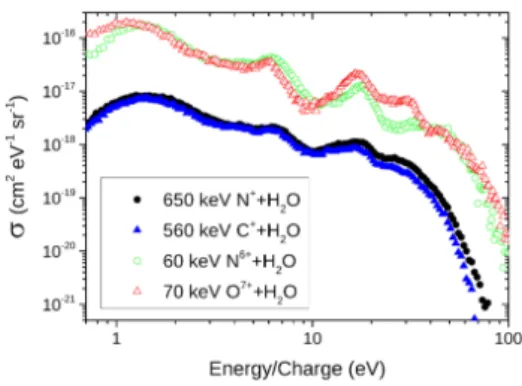Journal of Physics: Conference Series
PAPER • OPEN ACCESS
Dissociative multiple ionization of the H 2 O
molecule induced by ion impact: experimental and theoretical results
To cite this article: S T S Kovas et al 2020 J. Phys.: Conf. Ser. 1412 152071
View the article online for updates and enhancements.
You may also like
Classical trajectory Monte Carlo model calculations for ionization of the uracil molecule by impact of heavy ions L Sarkadi
-
Single ionization of water molecules in collisions with bare ions
A Mondal, C R Mandal and M Purkait -
Experimental and theoretical results on electron emission in collisions between He targets and dressed Liq+ (q = 1, 2) projectiles
D Fregenal, J M Monti, J Fiol et al.
-
This content was downloaded from IP address 193.6.177.61 on 23/11/2021 at 10:43
Content from this work may be used under the terms of theCreative Commons Attribution 3.0 licence. Any further distribution of this work must maintain attribution to the author(s) and the title of the work, journal citation and DOI.
Published under licence by IOP Publishing Ltd
ICPEAC2019
Journal of Physics: Conference Series 1412 (2020) 152071
IOP Publishing doi:10.1088/1742-6596/1412/15/152071
1
Dissociative multiple ionization of the H
2O molecule induced by ion impact: experimental and theoretical results
S T S Kova´cs1∗, P Herczku1, Z Juh´asz1, L Sarkadi1, L Guly´as1, J-Y Chesnel2 and B Sulik1
1Institute for Nuclear Research, Hungarian Academy of Sciences (MTA Atomki), Debrecen, H-4026, Hungary
2Centre de Recherche sur les Ions, les Mat´eriaux et la Photonique, Normandie Univ, ENSICAEN, UNICAEN, CEA, CNRS, CIMAP, Caen, 14000, France
Synopsis Fragment energy spectra of the water molecule impacted by singly charged (SCI) and highly charged (HCI) ions have been measured in crossed beam experiments. Double differential fragmentation cross sections (DDCS) have been determined. Similarities and differences of the measured DDCSs induced by the medium- and low-energy projectiles have been analyzed. Multiple target ionization cross sections have been deduced and they were further analyzed through the results of the CTMC and CDW-EIS models.
We present experimental results on the Coulomb explosion of H2O molecules, bom- barded by different types of projectile ions. The initial multiple vacancy production in the target molecule is further analyzed through the results of CTMC and CDW-EIS calculations.
Gas phase water molecules were impacted by medium-energy singly charged (560 keV C+and 650 keV N+) and low-energy highly charged (60 keV N6+ and 70 keV O7+) ions [1, 2]. The energy and angular distributions of the charged fragments were measured by single-stage electro- static spectrometers. Double differential frag- mentation cross sections have been deduced.
Figure 1. Measured fragmentation cross sections for the four different projectiles at 45 observation angle.
The shape of the spectra is found to be very similar for C+, N+ and N6+ impact (see Figure 1.). Though the dominant ioniza- tion mechanism and the average perturbation
strength is different for SCIs and HCIs, the similarity indicates that the same fragmentation channels appear in the collisions. While the SCI induced spectra are almost identical, slight differ- ences in the relative intensities of the structures were found between the SCI and HCI induced spectra, as well as between the spectra induced by the two HCIs. It was attributed to the selec- tivity of the electron capture process compared to the direct ionization.
From the fragment ion spectra multiple ion- ization (MI) cross sections have been deduced.
We found that the highest degrees of ionizations for the two SCIs approach those for the HCIs with non-negligible yields. The MI cross sections were further analyzed through the results of clas- sical (CTMC) and quantum mechanical (CDW- EIS) model calculations [1, 3]. The calculated MI cross sections almost coincide with the exper- imental data for C+and N+impact, and are only in qualitative agreement with the measured HCI results. Further analysis have been performed through the calculated impact parameter depen- dent MI probabilities.
Work was supported by the Hungarian OTKA (Grants No. K109440 and K128621), the CNRS-MTA Cooperation (Grant No. 26118) and by the PHC Balaton Program(Grant No.
38620NH/T´eT 16-1-2016-2026).
References
[1] Kovacs S T Set al2017Phys. Rev. A96032704 [2] Sobocinski Pet al2006J. Phys. B39927 [3] Kovacs S T Set al2016Phys. Rev. A94012704
∗E-mail: kovacs.sandor@atomki.mta.hu
